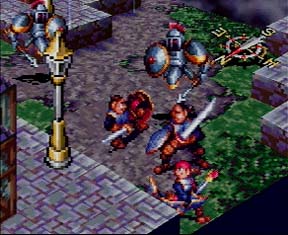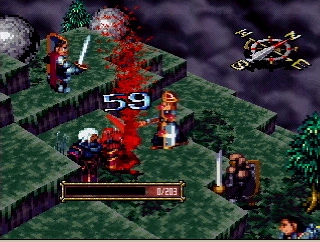|
|

|
PLATFORM
|
Saturn
|
BATTLE SYSTEM
|

|
INTERACTION
|

|
ORIGINALITY
|

|
STORY
|

|
MUSIC & SOUND
|

|
VISUALS
|

|
CHALLENGE
|
Acceptable
|
COMPLETION TIME
|
20-25 hours
|
|
OVERALL

|
Click here for scoring definitions
|
|
|
There was a time when the Saturn was a contender against its system rivals. That time was very brief outside Japan, but in the Land of the Rising Sun enough consumers purchased Saturn titles to make porting some titles from the PS1 good business sense. Such was the case with Vandal Hearts, which landed on the Japanese Saturn for the benefit of all the tactical aficionados. The wealth of tactical goodness on the Saturn makes this game less than perfection when set against certain titans for the system, but the game is most assuredly playable and enjoyable on its own terms.
Vandal Hearts possesses a plot paying homage to the best Hollywood tradition of blatant rewriting. It takes the expected elements of any tactical title dealing with political intrigue and rebellion, and then throws it all into an ill-developed mix. A character coming out of nowhere to join turns out to be - A SPY? A man deep in the imperial government wants - SUPREME POWER? The empire is - OPPRESSING ITS CITIZENS? The incomplete (English) game script on the Internet makes clear just how unoriginal the plot is, but even in Japanese there is little that will be unclear to the veteran RPGamer while playing.
 Wait, I thought YOU were controlling the empty suit of armor! Uh-oh...
Wait, I thought YOU were controlling the empty suit of armor! Uh-oh...
|
|
Resolution of disagreements between the player-controlled characters and the enemy is conducted in more-or-less typical tactical RPG fashion. Battles are conducted something like Shining Force, though there is no quick cutaway to an animation of actions being conducted. Unlike Shining Force but like Fire Emblem, the player will be able to move all units in any order. The player can end the turn at any time, and then enemies will be able to move. Also in Fire Emblem fashion the player (and the enemy) will be counterattacked when able. Which direction a character is facing influences how much damage is dealt, and there are somewhat random instances when characters on both sides will completely block an attack. Attacking enemies or using healing methods nets experience for characters, with class changes available at higher levels. Money is netted post-battle from all the kills, minus money automatically taken away to revive fallen allies.
What sets Vandal Hearts apart from other tactical titles is the ability to push things around the battlefield. Crates that are inexplicably in some of the fighting zones can be used to block off avenues of attack for the opposition, and rocks can be used for a linear attack that will halve the life of anything in the way. Archers also seem to possess abnormally long attack ranges in this title.
 The gemstones Gigan was stuffed into multiply, and the world braces itself for more Godzilla monsters!
The gemstones Gigan was stuffed into multiply, and the world braces itself for more Godzilla monsters!
|
|
Interaction outside of battle is very simple. The menus are constructed in such a way as to easily purchase new equipment without being forced into a purchase before seeing its effect upon the recipient, and conveniently allow prompt resale of the discarded items within the same transaction. Navigating the world is easy thanks to its linearity. Inside battle the menus are mostly fine as well, with the glaring exception being the inability to reorient a character after attacking/using an item/using magic. This often means a character is exposed to massive damage from enemies with the player being unable to do a thing save hope. This is partly made up for by being able to push items and move repeatedly during a character's action phase, but is still quite unpleasant at times. There is also the often-infuriating choice of the designers to use an isometric view, which can be shifted around but never altered to present an overhead perspective.
As to the class-change aspect: upon reaching level 10 each character is allowed to proceed to a different, more powerful class. The initial class change is between two types, but at level 20 a character can class-change again to a fixed class dependent upon what the initial class chosen was. Class-changing equates to greater move range and attack range (in the case of bow & arrow users), along with statistic increases that may not be readily apparent.
 Vandal Hearts subscribes to the horror movie aesthetic 'more blood is best!'
Vandal Hearts subscribes to the horror movie aesthetic 'more blood is best!'
|
|
Visually Vandal Hearts is adequate enough without being stunning. The Saturn has no problem with this stuff, even the gouts of blood from every living foe brought down. Nothing is ugly, nothing truly impresses. Aurally the music is perfectly acceptable without being memorable in any way. A generic tactical soundtrack is heard within. The only instance of voice acting comes from a fairly monotone narrator describing events at the beginning of each chapter.
Vandal Hearts does not take very long by tactical standards to complete - 20 hours is a perfectly achievable goal for finishing it. Aside from exploring unseen classes (not terribly likely given the paucity of class choices in the first place) and perhaps going through an optional quest dependent upon finding items strewn across battlefields to garner a secret class for the protagonist, there is no incentive for replay. True, there are hidden items in most of the battles, but finding them does not make or break the experience. Insofar as challenge goes, the automatic revival of characters post-battle and the awarding of sufficient fund to let this not drag on the wallet help make the game brain-stretching without being brain-straining. Some battles are more challenging than others but the ability to instantly retry any failed battle also reduces frustration.
Vandal Hearts is certainly interesting enough to warrant a test by any tactical player. Playing the Saturn version is probably unnecessary given the presence of the PS1 title in English, but the game is linear enough to cross the language barrier easily. Despite some odd choices (why is the art for the loading screens done by a different artist than the art during the rest of the game?) the game does grip a tactical player's attention during play.
Review Archives
|









